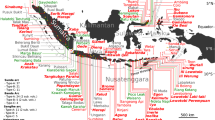Abstract
Mercury is the principal metal emitted in vapour form by volcanoes and other natural geothermal sources. Direct evidence for the release of mercury at volcanic, fumarolic and hydrothermal sites has been obtained in Hawaii, Iceland, Antarctica and the Pacific north-west1–6, and the relationship of mercury to volcanic activity elsewhere has been inferred from the analysis of indicator plants7,8. The relation of volcanogenic mercury to total atmospheric content has been a matter of some uncertainty. From 1971 to 1980, mercury and sulphur dioxide analyses were carried out on air samples collected immediately downwind of Halemaumau, the Kilauea main vent, in Hawaii. From these measurements, a Hg/SO2 ratio of 0.51 × 10−3 was derived. As reported here, applying this ratio to the recently determined sulphur dioxide mass output of Halemaumau, yields a calculated mercury flux of 2.6 × 108g annually. This value is consistent with recent evidence6 suggesting that volcanogenic mercury contributes significantly to the atmospheric total.
Similar content being viewed by others
References
Siegel, B., Siegel, S. & Thorarinsson, F. Nature 241, 526–527 (1973).
Siegel, S. & Siegel, B. Envir. Sci. Technol. 9, 473–474 (1975).
Siegel, S. & Siegel, B. Wat. Air Soil Pollut. 9, 113–118 (1977).
McMurty, G., Brill, R., Siegel, B. & Siegel, S. U.S. Antarctic J. 14, 206–209 (1979).
Siegel, B. & Siegel, S. in Biogeochemistry of Mercury in the Environment (ed. Nriagu, J.) 131–159 (Elsevier, Amsterdam, 1979).
Varekamp, J. & Buseck, P. Nature 293, 555–556 (1981).
Siegel, B. & Siegel, S. Science 216, 292–294 (1982).
Siegel, S. & Siegel, B. Adv. Space Res. 3, 135–139 (1983).
An Assessment of Mercury in the Environment (U.S. natn. Acad. Sci., Washington, DC, 1977).
Anderson, A. Rev. Geophys. Space Phys. 13, 37–55 (1974).
Andren, W. & Nriagu, J. in Biogeochemistry of Mercury in the Environment (ed. Nriagu, J.) 113–130 (Elsevier, Amsterdam, 1979).
McNeal, J. & Rose, A. Geochim. cosmochim. Acta 43, 1759–1784 (1979).
Stoiber, R. & Jepson, A. Science 182, 577–578 (1973).
Siegel, B. & Siegel, S. Envir. Sci. Technol. 12, 1036–1039 (1978).
Ambient Air Monitoring Reference and Equivalent Methods Fed. Register 40(33) 7044 (1975).
Ambient Air Monitoring Reference and Equivalent Methods Fed. Register 40(232) 52692 (1976).
Burmann, F. & Rehme, K. in Methods for the Assessment of Air Pollution Effects on Vegetation: A Handbook (eds Heck, W., Krupa, S. & Linzen, S.) 2–1 to 2–24 (Air Pollution Control Ass., Pittsburgh, (1979).
MacDonald, G. & Abbott, A. Volcanoes in the Sea, 312–314 (University of Hawaii Press, Honolulu, 1970).
Stoiber, R., Williams, J. & Huebert, F. EOS 62, 1152–1155 (1979).
Simkin, T. et al. Volcanoes of the World, 1–232 (Hutchinson Ross, Stroudsberg, Pennsylvania, 1981).
Author information
Authors and Affiliations
Rights and permissions
About this article
Cite this article
Siegel, S., Siegel, B. First estimate of annual mercury flux at the Kilauea main vent. Nature 309, 146–147 (1984). https://doi.org/10.1038/309146a0
Received:
Accepted:
Issue Date:
DOI: https://doi.org/10.1038/309146a0
- Springer Nature Limited
This article is cited by
-
New clues on the contribution of Earth’s volcanism to the global mercury cycle
Bulletin of Volcanology (2011)
-
Atmospheric Monitoring at Abandoned Mercury Mine Sites in Asturias (NW Spain)
Environmental Monitoring and Assessment (2007)
-
Temporal variability in SO2 exposures at Hawai’i Volcanoes National Park, USA
Environmental Geology (2007)
-
Mercury degassing rate from mineralized areas in the Mediterranean basin
Water, Air, & Soil Pollution (1997)
-
Biomonitoring of atmospheric mercury in the vicinity of Kilauea, Hawaii
Water, Air, and Soil Pollution (1996)





